If you’ve never cooked with ground venison, you might be missing out on one of the best-kept secrets in the kitchen. It’s lean, packed with flavor, and surprisingly easy to work with. But here’s the thing—many people think cooking venison is tricky or that it will turn out dry. The truth? With the right approach, it’s just as simple as beef, but even better for you! Imagine biting into a juicy, perfectly seasoned burger or a rich, hearty stew that warms you up from the inside. Sounds good, right?
Now, let’s talk about why this is a game-changer. Venison isn’t just delicious—it’s versatile, sustainable, and a great alternative to traditional meats. Whether you’re making quick weeknight meals or a cozy dish for the family, it fits right in. Plus, once you get the hang of it, you’ll wonder why you didn’t try it sooner. Keep reading—you’re going to love what’s next!
Table of Contents
Why Ground Venison is a Lean and Flavorful Choice
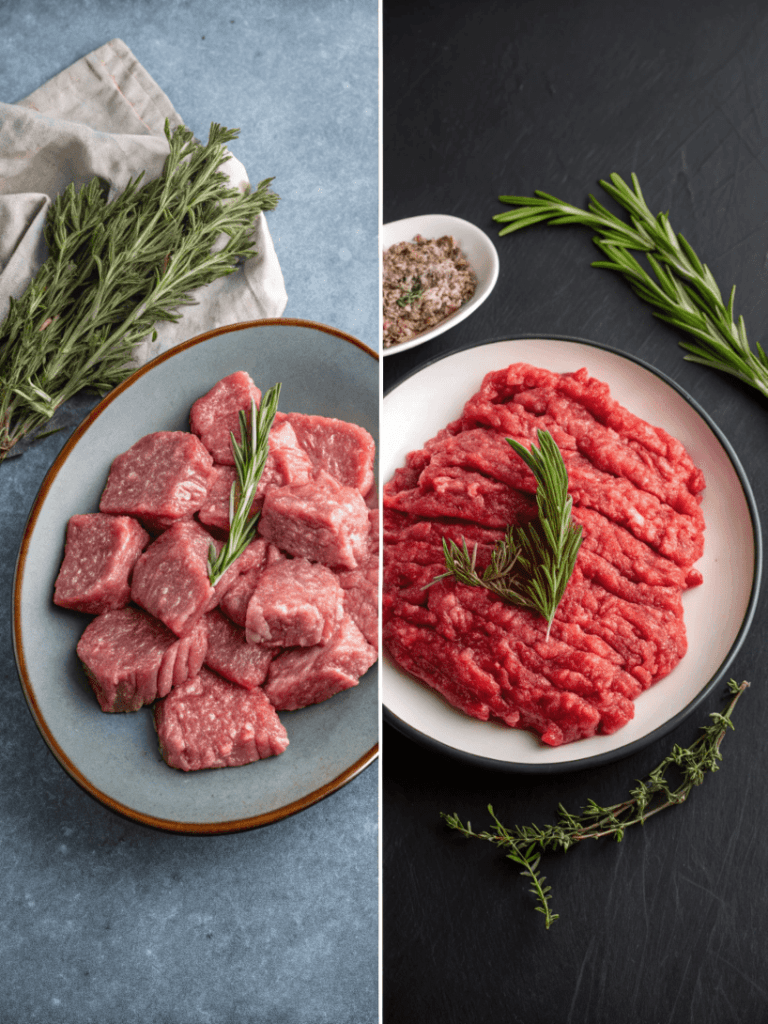
Nutritional Benefits and Health Perks
Ground venison is a powerhouse of nutrients. It’s lean, rich in protein, and packed with essential vitamins and minerals. If you’re looking for a healthy alternative to beef, this is a great choice. Since venison is naturally low in fat, it helps keep meals lighter while still being filling. Plus, it’s packed with iron, which keeps your energy levels up throughout the day.
One of the best things about ground venison is its high protein content. Each serving gives your body the fuel it needs to build muscle and stay strong. It’s also a great source of B vitamins, including B12, which helps with brain function. Unlike processed meats, venison doesn’t have additives or preservatives. You’re getting pure, natural meat with every bite.
Another perk? It’s easier to digest than some other meats. Since it’s leaner, your body breaks it down more efficiently. This makes it a great option for those looking to eat healthier without sacrificing taste. Also, venison contains omega-3 fatty acids, which are good for your heart. These healthy fats help reduce inflammation and keep your cholesterol in check.
If you’re counting calories, venison is a smart pick. It has fewer calories than beef while still providing a rich, meaty flavor. This means you can enjoy hearty meals without worrying about excessive fat or extra calories. And because it’s naturally flavorful, you don’t need a lot of seasoning to make it taste great.
Here’s a quick comparison of ground venison vs. other meats:
| Nutrient | Ground Venison | Ground Beef | Ground Turkey |
|---|---|---|---|
| Calories (per 3.5 oz) | 158 | 250 | 176 |
| Protein (g) | 26 | 22 | 24 |
| Fat (g) | 3 | 17 | 9 |
| Iron (%) | 15% | 12% | 8% |
| Omega-3s | High | Low | Moderate |
As you can see, ground venison is a great option if you want a protein-packed, low-fat meat with a ton of nutrients. It’s tasty, nutritious, and easy to cook. If you haven’t tried it yet, now’s the perfect time!
Love rich and bold flavors? Try this beef cheek meat recipe for another melt-in-your-mouth dish!
Selecting the Best Cuts for Ground Venison
Not all venison cuts are the same. Some work better for grinding than others. Choosing the right cut makes all the difference in texture, taste, and juiciness. Since venison is lean, it’s important to pick cuts that will give you the best balance of flavor and tenderness.
The best cuts for ground venison come from the shoulder, neck, and hindquarters. These areas have just enough connective tissue to keep the meat from drying out. The backstrap and tenderloin are incredibly tender but are better suited for steaks rather than grinding.
Adding a little fat to ground venison can improve the texture. Many people mix it with beef fat or butter for a juicier bite. However, if you prefer pure venison, go for coarser grinds to maintain some moisture. Grinding it fresh also makes a difference. Pre-ground venison can dry out quickly, so it’s best to grind only what you need.
Here’s a breakdown of the best cuts for grinding:
| Cut Name | Best Use | Fat Content | Texture |
|---|---|---|---|
| Shoulder | Grinding, slow cooking | Low | Slightly firm |
| Neck | Grinding, stew meat | Low | Rich flavor |
| Hindquarter | Grinding, jerky | Medium | Lean but firm |
| Backstrap | Steaks, roasting | Very low | Extremely tender |
| Tenderloin | Grilling, pan-searing | Very low | Silky smooth |
Choosing the right cut makes a huge difference. It affects how your ground venison turns out, whether you’re making burgers, meatballs, or tacos. If you want the best results, grind it fresh and pick cuts with a little natural moisture. That way, every bite stays juicy and full of flavor!
How to Cook Ground Venison for the Best Taste and Texture
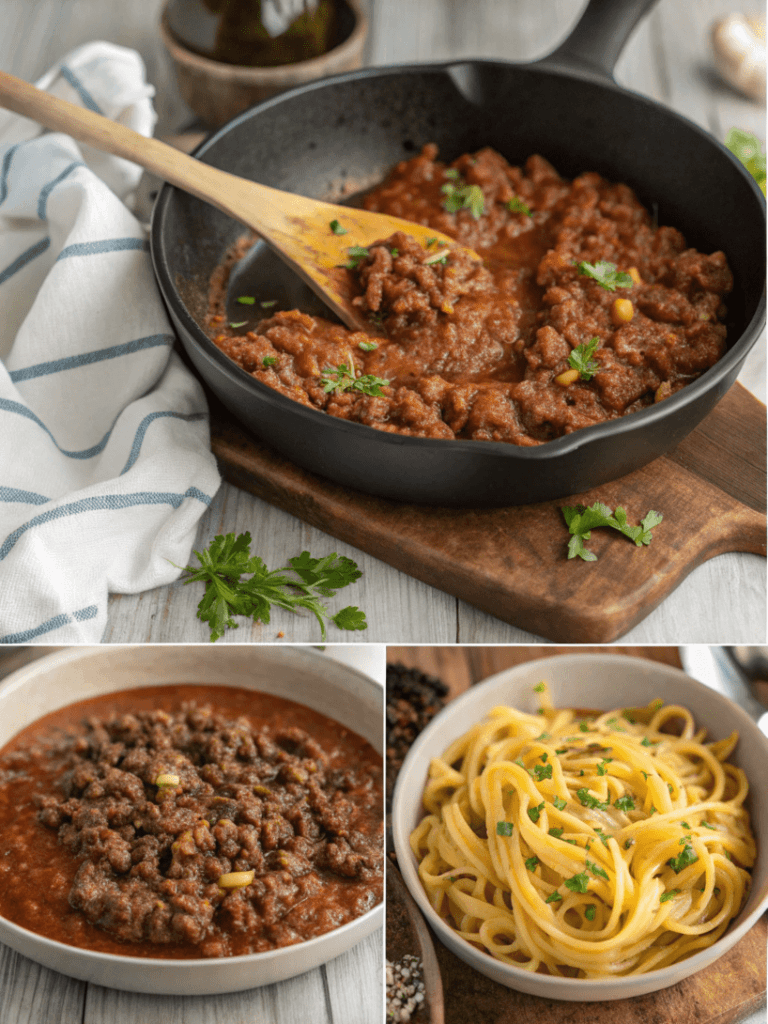
Overcoming Lean Meat Challenges for Juicier Results
Ground venison is naturally lean, which means it can dry out quickly if not cooked properly. Since it has less fat than beef, you need to take a few extra steps to keep it juicy and flavorful. One trick is to cook it at a lower temperature. High heat can cause the meat to lose moisture too fast, making it tough. Instead, cook venison over medium or medium-low heat to retain its tenderness.
Another great way to prevent dryness is by adding moisture-rich ingredients. A little olive oil, butter, or broth can make a big difference. If you’re making burgers or meatballs, mixing in grated onions, eggs, or even a bit of yogurt helps keep the texture soft and moist. You can also blend it with vegetables like mushrooms or zucchini for extra juiciness.
Timing is also important. Venison cooks faster than beef, so keep an eye on it. Overcooking can make it chewy. Aim for an internal temperature of 160°F (71°C) for ground venison. If you’re browning it for tacos or pasta, cook just until the pink disappears.
Mixing venison with a small amount of beef fat or butter can also help. If you prefer a pure venison taste, using a coarser grind can prevent it from becoming too dense. Letting the meat rest for a few minutes after cooking also helps keep the juices inside.
Here’s a quick comparison of cooking methods for ground venison:
| Cooking Method | Heat Level | Best Uses | Moisture Retention |
|---|---|---|---|
| Pan-searing | Medium | Burgers, patties | Moderate |
| Slow cooking | Low | Chili, stew | High |
| Grilling | Medium-high | Burgers, sausages | Low |
| Baking | Medium | Meatloaf, casseroles | High |
By following these simple steps, you can make sure every bite of ground venison is juicy and packed with flavor.
Best Seasonings and Ingredients for Maximum Flavor
Venison has a rich, deep flavor that pairs well with many seasonings. Since it’s leaner than beef, it absorbs marinades and spices quickly. The key is to balance the natural taste without overpowering it.
- Herbs: Rosemary, thyme, and oregano bring out venison’s earthy tones.
- Spices: Garlic powder, smoked paprika, and cumin add warmth and depth.
- Acidic Ingredients: A splash of balsamic vinegar or lemon juice enhances the meat’s natural flavor.
- Moisture Boosters: Olive oil, butter, or broth keep the meat tender.
- Sweet and Savory Mix: A hint of brown sugar or maple syrup balances the bold taste.
If you’re making burgers, adding Worcestershire sauce or mustard enhances the umami flavor. For tacos, cumin and chili powder work well. If you’re cooking venison for pasta or casseroles, a bit of tomato paste deepens the richness.
Here’s a simple flavor guide based on different dishes:
| Dish Type | Best Seasonings | Recommended Ingredients |
|---|---|---|
| Burgers | Black pepper, Worcestershire sauce | Onion, garlic, butter |
| Tacos | Cumin, chili powder, oregano | Lime juice, cilantro, tomatoes |
| Meatballs | Garlic, basil, thyme | Parmesan, breadcrumbs, eggs |
| Stews | Bay leaves, paprika, rosemary | Carrots, potatoes, broth |
Experiment with different flavors to find what you love most. With the right seasoning, ground venison can shine in any dish! Want a unique pasta to pair with your venison dish? Check out this Gigli Pasta Guide to elevate your next meal!
Delicious Ground Venison Recipes for Any Occasion
Classic Venison Burgers and Meatballs
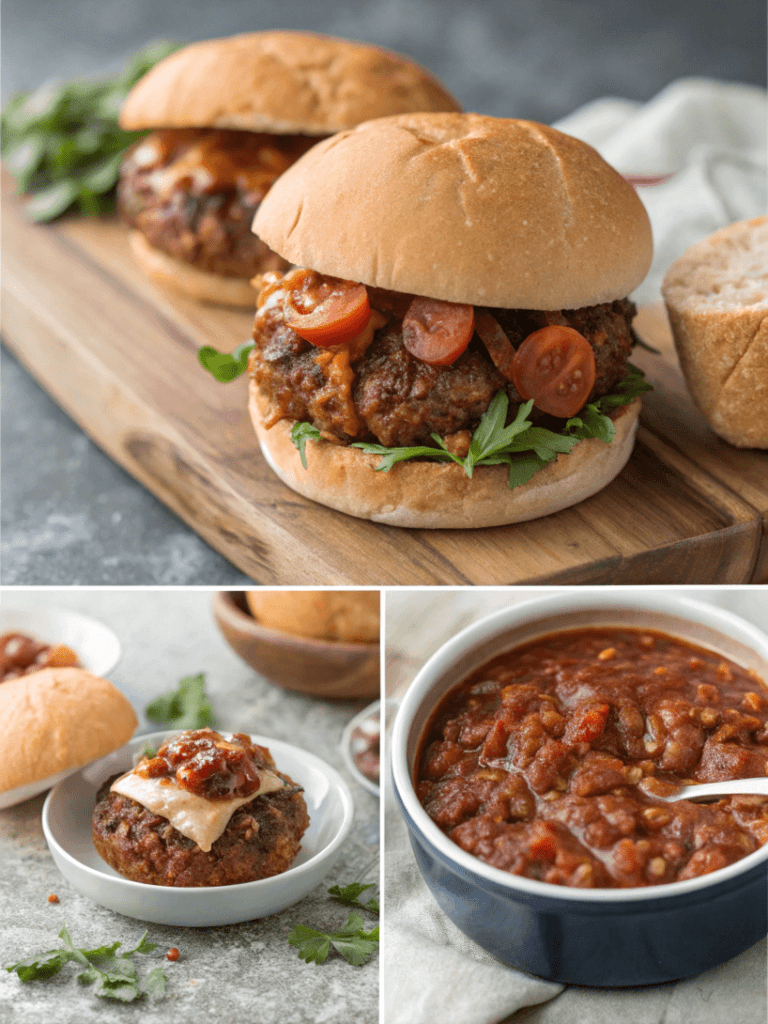
Ground venison makes some of the most flavorful burgers and meatballs you’ll ever try. Since venison is lean, the key to making juicy burgers is adding a little moisture. You can mix in eggs, breadcrumbs, or even a bit of butter to keep them soft and tender. A splash of Worcestershire sauce or soy sauce also deepens the flavor.
When shaping burgers, avoid pressing them too hard. Keeping them light and airy helps them stay juicy while cooking. Cook them over medium heat to prevent them from drying out. A quick flip is all they need—don’t press them down with a spatula, or you’ll lose the juices. For an extra boost, top with caramelized onions and a slice of cheddar.
Meatballs are just as easy to make. Mix the venison with breadcrumbs, Parmesan cheese, and fresh herbs for a burst of flavor. Browning them in a pan before adding them to sauce locks in the juices. They work great in spaghetti, subs, or even on their own with a side of roasted vegetables.
Here’s a quick comparison of venison burgers vs. beef burgers:
| Feature | Venison Burgers | Beef Burgers |
|---|---|---|
| Fat Content | Low | Higher |
| Flavor | Rich, slightly sweet | Mild, meaty |
| Cooking Time | Shorter | Longer |
| Best Additions | Butter, Worcestershire sauce, onions | Cheese, bacon, mustard |
If you’re new to cooking ground venison, burgers and meatballs are a great place to start. They’re simple, delicious, and a guaranteed crowd-pleaser.
Hearty Casseroles, Stews, and One-Pan Meals
Ground venison is perfect for cozy meals like casseroles, stews, and one-pan dishes. Since it’s lean, it works well in recipes that include a sauce or broth. This keeps the meat tender while letting it soak up all the rich flavors.
- Venison Chili: Slow-cooked with tomatoes, beans, and spices for a bold, hearty dish.
- Shepherd’s Pie: A comforting blend of venison, mashed potatoes, and vegetables.
- Stuffed Peppers: Bell peppers filled with venison, rice, and seasonings, then baked to perfection.
- Venison Lasagna: Layers of pasta, cheese, and venison-packed sauce for an irresistible meal.
For stews, browning the venison first adds depth to the flavor. Then, simmering it in broth with carrots, onions, and potatoes makes it fork-tender. Slow cookers and pressure cookers are great for this. They break down the meat, making it even more flavorful.
One-pan meals make cleanup easy. Try cooking venison with sweet potatoes and Brussels sprouts on a single tray. Add a drizzle of olive oil and a sprinkle of garlic powder for a meal that’s both simple and tasty.
Here’s a quick guide on cooking times for different venison dishes:
| Dish | Cooking Time | Best Cooking Method |
|---|---|---|
| Chili | 4-6 hours | Slow cooker |
| Shepherd’s Pie | 45 minutes | Oven |
| Stuffed Peppers | 30 minutes | Oven |
| One-Pan Meal | 25 minutes | Stovetop/Oven |
Ground venison is incredibly versatile. Whether you want something quick or a slow-cooked meal, there’s a recipe for every occasion. Try one of these dishes and see how easy it is to cook with venison!
Craving a show-stopping dinner? Try this ribeye roast recipe for a flavorful alternative!
Storage, Handling, and Food Safety Tips for Ground Venison
Proper Freezing and Thawing Methods
Storing ground venison the right way keeps it fresh and flavorful for months. Since venison is lean, it can dry out faster than other meats if not stored properly. Freezing is the best way to keep it fresh, but the trick is to remove as much air as possible before sealing. Vacuum sealing is ideal, but if you don’t have a vacuum sealer, pressing out the air from freezer bags works well too.
For best results, freeze ground venison in small portions. This way, you only thaw what you need without having to refreeze leftovers. Wrapping the meat in butcher paper before sealing it in a freezer bag adds extra protection against freezer burn. Labeling the package with the date helps you keep track of freshness.
When it’s time to thaw, always do it in the refrigerator. Letting it thaw slowly over 12-24 hours keeps the texture intact. If you’re in a hurry, submerge the sealed package in cold water, changing the water every 30 minutes. Avoid thawing venison at room temperature, as bacteria can grow quickly.
Here’s a quick guide to freezing and thawing:
| Method | Best Practice | Time Required |
|---|---|---|
| Freezing | Vacuum-sealed or double-wrapped | Up to 12 months |
| Refrigerator Thawing | Place in a bowl to catch drips | 12-24 hours |
| Cold Water Thawing | Submerge in sealed bag, change water often | 1-2 hours |
| Microwave Thawing | Use defrost setting, cook immediately | Minutes, but may dry out |
By following these methods, you’ll keep your ground venison tasting as fresh as the day it was packed!
Cooking Temperatures and Safe Preparation Practices
Cooking ground venison safely ensures that every meal is both delicious and free from foodborne risks. Since venison is leaner than beef, it’s important to cook it to the right temperature without overdoing it.
- Cook ground venison to at least 160°F (71°C). This ensures harmful bacteria are destroyed while keeping the meat tender.
- Use a meat thermometer. Checking the internal temperature prevents guesswork and overcooking.
- Don’t eat rare venison. Unlike steaks, ground venison needs to be fully cooked to avoid health risks.
- Avoid cross-contamination. Keep raw venison separate from other foods, especially vegetables.
- Wash hands and surfaces after handling raw venison. This simple step helps prevent bacteria spread.
Overcooking venison can make it dry, so using cooking methods that retain moisture is key. Adding a little olive oil or butter while cooking helps maintain juiciness. If browning ground venison for a dish like chili or pasta sauce, add liquid like broth or tomato sauce to keep it from drying out.
For a quick comparison, here’s how venison cooking temperatures compare to other meats:
| Meat Type | Safe Internal Temperature | Best Cooking Method |
|---|---|---|
| Ground Venison | 160°F (71°C) | Pan-searing, baking, slow cooking |
| Beef Burgers | 160°F (71°C) | Grilling, pan-frying |
| Chicken | 165°F (74°C) | Baking, grilling |
| Fish | 145°F (63°C) | Grilling, pan-searing |
By following these food safety practices, you’ll get the best flavor while keeping every meal safe and satisfying!
Sustainable and Ethical Aspects of Choosing Venison
Responsible Sourcing and Ethical Hunting Practices
Choosing ground venison means supporting ethical and sustainable food practices. Unlike factory-farmed meat, venison often comes from wild sources, ensuring a more natural and humane process. Ethical hunters follow strict guidelines, harvesting only what is necessary while respecting wildlife populations. This keeps ecosystems balanced and prevents overpopulation issues that can harm local habitats.
One key principle of ethical hunting is fair chase. This means hunters give animals a chance to evade, avoiding unfair or excessive methods. Responsible hunters also use quick, humane techniques to minimize suffering. This approach ensures that every harvested deer serves a purpose, from providing high-quality meat to using hides and bones for other resources.
Hunting regulations and permits also play a role in sustainability. Many regions have seasonal limits and specific rules on which deer can be hunted. This prevents overhunting and helps maintain stable deer populations. Venison sourced from well-managed hunting programs is an eco-friendly alternative to commercial meat production, reducing the demand for factory-farmed beef.
For those who prefer farm-raised venison, choosing sources that follow ethical breeding practices is important. Farms that provide free-range environments and natural diets create healthier meat while treating animals with care. Whether wild or farm-raised, sourcing venison responsibly supports ethical food consumption.
Here’s a quick comparison between wild and farm-raised venison:
| Feature | Wild Venison | Farm-Raised Venison |
|---|---|---|
| Diet | Natural, wild forage | Controlled, grain-fed |
| Sustainability | High | Moderate |
| Flavor | Rich, slightly gamey | Milder |
| Availability | Seasonal | Year-round |
Environmental Benefits of Eating Venison
Eating ground venison is one of the most environmentally friendly choices you can make. Unlike industrial meat production, venison has a much smaller carbon footprint. Since deer live in the wild and forage naturally, there’s no need for large-scale farming, excessive feed, or artificial growth hormones.
- Lower Carbon Emissions: Venison doesn’t require factory farming, reducing methane emissions and pollution.
- Minimal Land Impact: Deer roam freely, so there’s no need for deforestation or large pastures.
- No Chemical Additives: Wild venison is free from antibiotics and synthetic hormones found in commercial meats.
- Supports Local Ecosystems: Responsible hunting helps control deer populations, preventing habitat damage.
- Less Water Usage: Compared to cattle farming, venison requires significantly less water resources.
Sourcing venison locally also reduces transportation-related emissions. Instead of relying on imported or heavily processed meats, venison offers a farm-to-table experience with minimal waste. When processed properly, nearly every part of the deer can be used, from meat to hides, making it a zero-waste protein choice.
Here’s how venison compares to other meats in terms of environmental impact:
| Factor | Venison | Beef | Chicken |
|---|---|---|---|
| Carbon Footprint | Low | High | Moderate |
| Land Use | Minimal | Extensive | Moderate |
| Water Consumption | Low | High | Moderate |
| Chemical Additives | None | Common | Some |
By choosing venison, you’re making a sustainable and ethical food choice. It’s a win-win for both your plate and the planet!
Now that you know why ground venison is a lean, flavorful, and sustainable choice, it’s time to put it to good use! Let’s dive into a hearty, comforting dish that’s easy to make and packed with rich, savory goodness—Savory Ground Venison and Vegetable Stew. Grab your ingredients, and let’s get cooking!
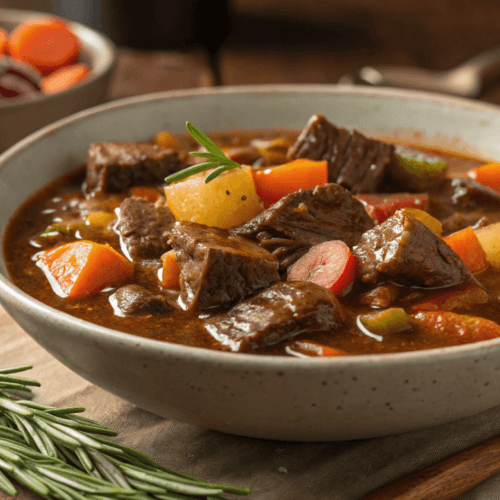
Savory Ground Venison and Vegetable Stew
Ingredients
- 1 lb ground venison
- 1 tbsp olive oil
- 1 small onion diced
- 2 cloves garlic minced
- 3 medium carrots sliced
- 2 celery stalks chopped
- 3 medium potatoes diced
- 1 can tomatoes diced
- 4 cups beef or vegetable broth
- 1 tsp salt
- ½ tsp black pepper
- 1 tsp dried thyme
- 1 tsp smoked paprika
- 1 bay leaf
Instructions
- Step 1: Brown the Venison – Heat the olive oil in a large pot over medium heat. Add the ground venison and cook for 5-7 minutes, breaking it apart with a spoon. Once it’s browned, transfer it to a plate and set it aside.

- Step 2: Sauté the Aromatics – In the same pot, add the diced onion, garlic, carrots, and celery. Cook for 3-5 minutes, stirring frequently until the vegetables begin to soften and release their natural sweetness.
- Step 3: Build the Base – Pour in the diced tomatoes, stir well, and let them simmer for 2 minutes. This allows the flavors to meld together and form a rich, tangy base.
- Step 4: Simmer to Perfection – Return the browned venison to the pot. Add the potatoes, broth, salt, black pepper, thyme, smoked paprika, and bay leaf. Bring everything to a gentle boil, then reduce the heat to low. Cover and let it simmer for 30-40 minutes, stirring occasionally.
- Step 5: Final Touches and Serving – Once the potatoes are fork-tender and the stew has thickened slightly, remove the bay leaf. Taste and adjust the seasoning if needed. Ladle into bowls and enjoy!
Notes
- Don’t skip browning the venison – This step enhances its deep, rich flavor and keeps it from tasting dry.
- For extra thickness, mash a few potatoes – This will give the stew a naturally creamy texture without needing flour or cornstarch.
- Use a slow cooker for easy prep – Cook on low for 6-8 hours or high for 3-4 hours for an effortless meal.
- Make it ahead of time – The flavors develop even more when stored overnight. Refrigerate for up to 4 days or freeze for up to 3 months.
Frequently Asked Questions (FAQs)
Is ground venison better than ground beef?
Ground venison is leaner than beef, making it a great choice if you want less fat but still crave rich flavor. It has a slightly sweet, earthy taste that pairs well with many seasonings. Also, venison is packed with protein and essential nutrients, making it a healthier option. Plus, it’s often free-range and more sustainable than factory-farmed beef. You’ll love the difference!
What is ground venison?
Ground venison is finely chopped deer meat, often sourced from the shoulder, neck, or hindquarters. It’s leaner than beef but still full of rich, meaty flavor. Since deer forage naturally, the meat has a wild, slightly sweet taste. You can use it in burgers, tacos, stews, or casseroles. It’s a fantastic protein option if you want something flavorful, healthy, and versatile.
How should ground venison be cooked?
Ground venison cooks best at medium or low heat to keep it from drying out. Because it’s lean, adding a little oil or butter helps retain moisture. Cook it just until the pink disappears, usually about 160°F. It works well in burgers, meatballs, and stews. For extra flavor, pair it with herbs, garlic, or onions. Once you try it, you’ll keep coming back!
Should you add anything to ground venison?
Yes! Because venison is lean, adding moisture helps keep it juicy. A little olive oil, butter, or broth works well. If making burgers or meatballs, mix in an egg or breadcrumbs for texture. Herbs, garlic, and spices enhance the flavor too. You can even blend it with beef fat for a richer bite. Play around with seasonings and find what you love!
Conclusion: Making Ground Venison a Staple in Your Kitchen
Cooking with ground venison is a game-changer. It’s lean, flavorful, and works in so many recipes. Whether you’re making burgers, stews, or casseroles, it adds a rich, hearty taste to every dish. Plus, it’s a healthier and more sustainable choice than many other meats. Once you try it, you’ll wonder why you didn’t cook with it sooner!
First, mastering the right cooking techniques helps keep it juicy and tender. Then, adding the right seasonings brings out its deep, natural flavors. In addition, choosing the best cuts and storage methods ensures the freshest results every time. The best part? It’s easy to experiment with, and every meal feels like a new adventure.
Now, it’s time to bring ground venison into your kitchen. Try a new recipe, play with flavors, and enjoy the process. Cooking should always be fun—and this ingredient makes it even better!

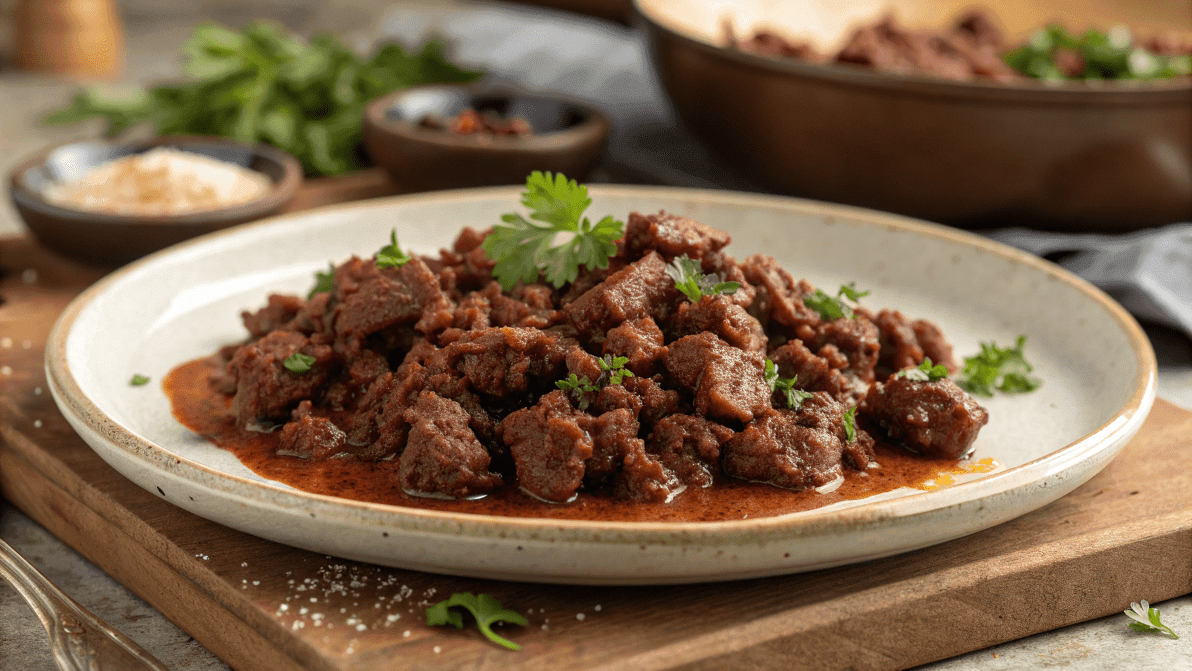
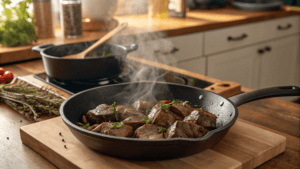
2 thoughts on “Ground Venison: The Ultimate Guide to Cooking, Storing and Enjoying This Lean Meat”